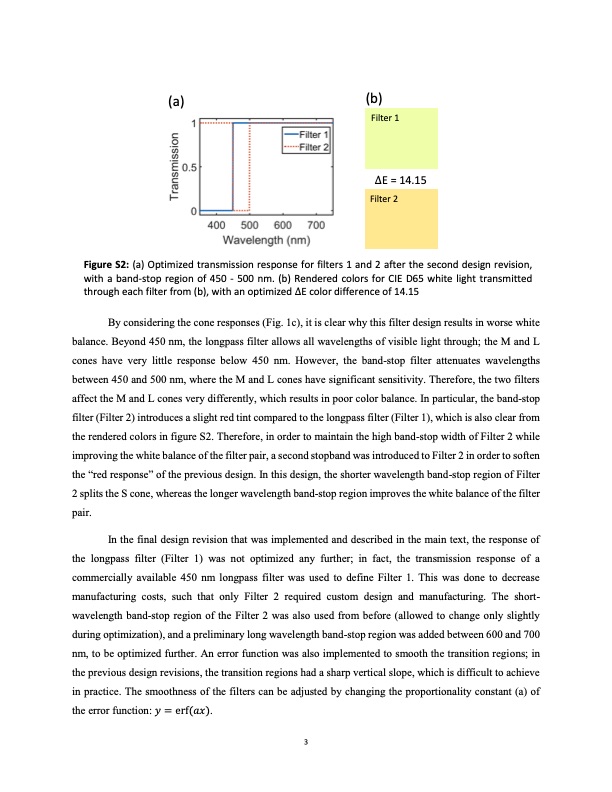
PDF Publication Title:
Text from PDF Page: 023
(a) (b) Filter 1 ΔE = 14.15 Filter 2 Figure S2: (a) Optimized transmission response for filters 1 and 2 after the second design revision, with a band-stop region of 450 - 500 nm. (b) Rendered colors for CIE D65 white light transmitted through each filter from (b), with an optimized ΔE color difference of 14.15 By considering the cone responses (Fig. 1c), it is clear why this filter design results in worse white balance. Beyond 450 nm, the longpass filter allows all wavelengths of visible light through; the M and L cones have very little response below 450 nm. However, the band-stop filter attenuates wavelengths between 450 and 500 nm, where the M and L cones have significant sensitivity. Therefore, the two filters affect the M and L cones very differently, which results in poor color balance. In particular, the band-stop filter (Filter 2) introduces a slight red tint compared to the longpass filter (Filter 1), which is also clear from the rendered colors in figure S2. Therefore, in order to maintain the high band-stop width of Filter 2 while improving the white balance of the filter pair, a second stopband was introduced to Filter 2 in order to soften the “red response” of the previous design. In this design, the shorter wavelength band-stop region of Filter 2 splits the S cone, whereas the longer wavelength band-stop region improves the white balance of the filter pair. In the final design revision that was implemented and described in the main text, the response of the longpass filter (Filter 1) was not optimized any further; in fact, the transmission response of a commercially available 450 nm longpass filter was used to define Filter 1. This was done to decrease manufacturing costs, such that only Filter 2 required custom design and manufacturing. The short- wavelength band-stop region of the Filter 2 was also used from before (allowed to change only slightly during optimization), and a preliminary long wavelength band-stop region was added between 600 and 700 nm, to be optimized further. An error function was also implemented to smooth the transition regions; in the previous design revisions, the transition regions had a sharp vertical slope, which is difficult to achieve in practice. The smoothness of the filters can be adjusted by changing the proportionality constant (a) of the error function: 𝑦 = erf(𝑎𝑥). 3PDF Image | Enhancing color vision by breaking binocular redundancy

PDF Search Title:
Enhancing color vision by breaking binocular redundancyOriginal File Name Searched:
enhancing-human-color-vision-670-nm.pdfDIY PDF Search: Google It | Yahoo | Bing
Cruise Ship Reviews | Luxury Resort | Jet | Yacht | and Travel Tech More Info
Cruising Review Topics and Articles More Info
Software based on Filemaker for the travel industry More Info
The Burgenstock Resort: Reviews on CruisingReview website... More Info
Resort Reviews: World Class resorts... More Info
The Riffelalp Resort: Reviews on CruisingReview website... More Info
| CONTACT TEL: 608-238-6001 Email: greg@cruisingreview.com | RSS | AMP |